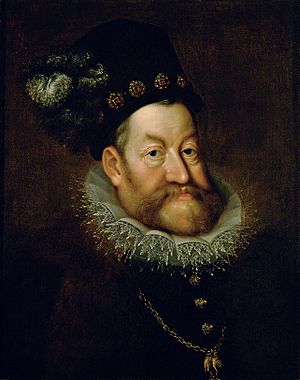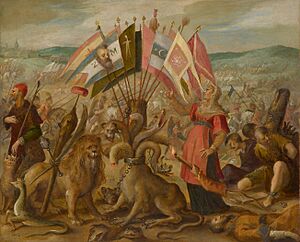Hans von Aachen facts for kids
Hans von Aachen (born 1552 – died March 4, 1615) was an important German painter. He was a leading artist of a style called Northern Mannerism.
Hans von Aachen was a very skilled artist who painted many different kinds of pictures. He was great at painting portraits of princes and nobles. He also painted scenes from the Bible, myths, and allegories (pictures that represent ideas). He is best known for these works. He also painted smaller pictures of people laughing, often using himself and his wife as models. Many of his paintings were small and done on copper.
Hans von Aachen's life and art show how ideas and styles moved between Northern, Southern, and Central Europe in the late 1500s and early 1600s. He first learned to paint in the style of the Netherlands. In 1574, he moved to Italy and stayed there for about 14 years, mostly in Venice. He came back to Germany in 1587 and lived in Munich. Later, he spent his final years in Prague. His unique painting style came from mixing the realistic art he learned in the Netherlands with the Italian art he saw during his travels.
He became famous around the world during his lifetime. This was because he worked in major art cities, many copies of his designs were made, and he had a friendly personality.
Contents
Life of a Famous Painter
Hans von Aachen was born in Cologne, Germany. His last name comes from his father's hometown, Aachen.
Early Training and Italian Travels
Hans von Aachen started learning to paint in Germany. His teacher was Georg Jerrigh, a portrait painter from Antwerp. Hans probably joined the painters' guild in Cologne before he left for Italy around 1574. Like many artists from the north, he spent a long time in Italy. He lived in Venice from 1574 to 1587. There, he joined a group of artists, printmakers, and art dealers from the Netherlands and Germany.
He copied famous artworks and worked for a Flemish art dealer named Gaspar Rem. Rem helped von Aachen learn from an artist called Morett. This training involved copying famous paintings found in Venice's churches. Many of these copies were sold in Northern Europe. A collector in Antwerp once owned six paintings by Hans von Aachen, including two copies he made after the famous artist Raphael.
In 1575, von Aachen went to Rome. He studied old Roman sculptures and the works of Italian masters. He became part of a group of northern artists in Rome. He even got a job to paint a Nativity for the Church of the Gesù, a main church for the Jesuits in Rome. In Florence, around 1582-1583, he became known for his portraits. This led to painting jobs for the powerful Medici family. In 1585, he moved back to Venice.
Return to Germany and Royal Service
Hans von Aachen returned to Germany in 1587. First, he went to Augsburg and painted portraits for the rich Fugger family. He also worked in Munich, where he painted two altarpieces for St. Michael's church. After visiting his hometown of Cologne and another trip to Venice, he decided to live in Munich starting in 1589. There, he married Regina, whose father was the famous composer Orlando di Lasso.
In Germany, he became very well known for painting portraits of noble families. He also created historical and religious scenes. He painted several works for Duke William V of Bavaria.
In Munich, he connected with the Imperial Court in Prague. In 1592, he was named the official painter for Emperor Rudolf II, who lived in Prague. Von Aachen didn't have to live at the court. He was a "court painter from home," meaning he could work from his own residence. Rudolf II loved art and was one of the most important art supporters of his time. He even said that painting was an "art of painting," not just a craft. This special treatment made Prague a major art center. The Emperor liked new art styles, and he supported a new, fancy style known as Mannerism.
Rudolf II also trusted von Aachen to advise him on his art collection. He even sent von Aachen on diplomatic missions. In this role, von Aachen traveled to convince art collectors to sell their treasures to the emperor. His travels were extensive. In 1602, he visited Brunswick, Wolfenbüttel, Wittenberg, and Dresden. Between 1603 and 1605, he went to Innsbruck, Venice, Turin, Mantua, and Modena. Some of these trips were to paint portraits of women who might marry the Emperor. Emperor Rudolf II made him a knight in 1605.
Von Aachen moved to Prague later, possibly in 1601 or even 1597. There, he received many jobs to paint mythological and allegorical subjects.
After his patron, Rudolf II, lost power in 1605 and died in 1612, von Aachen was kept on by the new emperor, Matthias I. Emperor Matthias sent him to Dresden and Vienna in 1612. In 1613, he was back in Augsburg, and in 1614, he was in Dresden again.
Hans von Aachen had several students, including Pieter Isaacsz in Italy, and Andreas Vogel, Christian Buchner, and Hans Christoph Schürer in Prague.
He was part of a group of artists in Rome who often visited Anthony van Santvoort.
Hans von Aachen died in Prague in 1615.
Hans von Aachen's Artworks
Painting Style and Subjects
Hans von Aachen was a very flexible artist. He painted portraits, historical scenes, religious pictures, everyday life scenes (genre pictures), and allegories. He was one of the main artists of the late Mannerist style. This style was popular at the court of Rudolf II in Prague around the year 1600. One famous example of his work is Allegory of Peace, Art and Abundance.
His style mixed different influences. It had an idealized look, similar to Roman and Florentine Mannerism. It also showed influences from Venetian masters like Titian, Veronese, and Tintoretto. At the same time, it included the new realistic style from Northern Europe. Von Aachen developed his own Mannerist technique by studying Tintoretto and followers of Michelangelo. Throughout his career, he was mainly influenced by Bartholomeus Spranger and Hendrick Goltzius, who were very important artists in Germany at that time.
Prints and Their Impact
Hans von Aachen himself did not make prints. However, his paintings were often copied by other court artists of Rudolf II. These included Wolfgang Kilian, Dominicus Custos, and members of the Sadeler family. These prints helped spread his fame and influence all over Europe. This happened even though the Mannerist style became less popular soon after his death.
Von Aachen also created original designs for the court's printmakers. One example is a series of prints called Salus generis humani (Salvation of Mankind). This series has 13 plates engraved by the Flemish printmaker Aegidius Sadeler, who worked at the Prague court. Made in 1590, these engravings show scenes from the Life of Christ based on Hans von Aachen's designs. The main pictures are surrounded by special borders. These border designs came from a prayer book made by the Flemish artist Joris Hoefnagel between 1581 and 1590.
Museums Where You Can See His Work
- Kunsthistorisches Museum, Wien, Austria
- Wallraf-Richartz Museum, Cologne, Germany
- Budapest Museum of Fine Arts, Budapest, Hungary
- The National Gallery, London
Images for kids
See also
 In Spanish: Hans von Aachen para niños
In Spanish: Hans von Aachen para niños





